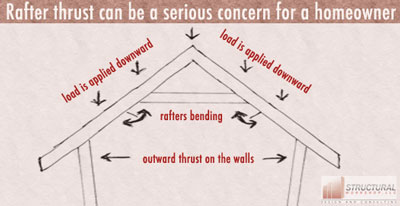
Rafter thrust occurs when the rafter tails (the bottom of the roof members of a sloped roof where the roof meets the wall) thrust outward and push the top of the wall outward. This can result in a bending outward at the top of the wall, as well as a dropping of the roof ridge. Connections can also pull apart. This action can happen independent of, or in conjunction with, sagging of the rafters or sagging of the ridge.
There are generally two conceptual designs for typical light framed residential roof construction. The first is a non-structural ridge. In this case, each sloped side of the roof and the attic floor members form a triangle. The ridge piece, which is at the peak of the roof, is usually a single 2x member, which acts a nailer, and is not performing any other structural function other than to attach the roof rafters to each other. Since the rafters are sloped, the downward forces of the self-weight of the roof, and any loads or snow on the roof, will push the bottom ends of the rafters both down and out. The downward force is resisted by the wall below. The outward force is resisted by the bottom piece of the triangle, in this case the attic floor joists. Most existing light frame construction is constructed in this manner, and almost all housing stock from the 50’s through the 80’s (typical Cape Cod, split level, bi-level, center hall colonial construction) is constructed in this manner.
When a cathedral or vaulted ceiling is present, the attic floor joists are not present. When this is the case, the wall can still resist the vertical loads, but there is no tie to resist the outward thrust. The proper way to frame a roof such as this is to make the ridge beam what is called a structural ridge. In this case, the beam will be an actual structural beam that is designed to support the top of the roof. When the top of the rafters are supported on a beam, as opposed to leaning on each other, the thrust at the base of the rafters is eliminated and the force at the base of the rafters becomes vertical only. A properly sized ridge beam can allow a properly functioning vaulted or cathedral ceiling to exist with no issues.
Issues arise when a roof is functioning as a cathedral ceiling although it is not designed to be one. This can occur due to design errors, field changes that the design professional was not aware of, or modifications to the structure after its construction is completed. Rafter thrust can be a slow process or it can occur rapidly. It can be benign or it can be dangerous. Solutions to rafter thrust generally entail tying the tops of the walls together across the space. This could be installation of an attic floor, or installation of wood or metal ties at selected intervals. Collar ties can assist with the rafter thrust, but their effectiveness is limited the higher they are on the rafters. Rafter thrust can be a serious concern for a homeowner, but is always a serious concern for a home buyer doing due diligence on a property. Damages from rafter thrust, as well as costs to address the condition, can be extensive and should be fully assessed by a Licensed Professional Engineer prior to purchasing a house. Solutions to rafter thrust should also be designed by a Licensed Professional Engineer.
